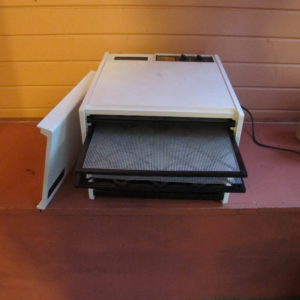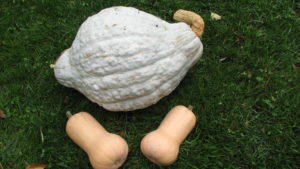How to Eat From Your Garden All Year
This was a good gardening year. Adequate rain, adequate sun. I know that I will have food from the vegetable garden that will allow me to eat something from it every day all year. Eating something every day from my garden is a bit of an obsession, but not all that hard to do. I am putting my root crops away for the winter now, and drying herbs.
My best crop this year was potatoes. In a 30-inch wide (double) row that was nearly 50 feet long I harvested about 125 pounds of potatoes including 5 different varieties. I had no potato beetles even though I used no pesticides, not even the organic Bt bacterial spray. My tip for doing so? Plant late. By mid-June potato beetles have started eating something, somewhere else. Maybe they were munching my neighbors’ potatoes, I don’t know.
When researching a book project in 2002 I drove around the country visiting farms and talking to farmers. In Idaho I worked for 3 weeks as a farm hand on an organic farm that grew potatoes, among other things.
I learned that potatoes need to be stored in a cool environment with high humidity. Commercially that meant storing them right at 50 degrees. At cooler temperatures some of the starches are converted to sugars. That would mean that French fries – America’s favorite potato product – would tend to darken up too much. I don’t make fries, and store my potatoes in a cold basement where they stay between 33 and 50 degrees. They’re very sweet.
Before I store my potatoes I harden them off outside for a few days. I place them on my north-facing deck where they get a good breeze, but not too much sun. I roll them over once a day so that all sides face up for a while.
If you don’t have a cold basement, get a spare fridge. These are often offered for sale used at $100 or less – and over the years I have gotten a couple free. They will keep root crops cool and keep mice from nibbling the harvest. If you keep it in the garage it will never run all winter, though you may need to add some heat inside it in January. A seed-starting heat mat will provide low heat for just a few pennies a week. Keep a thermometer inside it to monitor the temperature.
What else will store well in a fridge? Beets, carrots, rutabagas, kohlrabi and celeriac. Leeks should store well, but don’t. Those I clean, cut up, pack in zipper bags and freeze. Carrots will store well in the ground, but are targets for mice, so I pull them now.
Dried foods last all year, too. I dry tomatoes, herbs, apples, pears, berries and hot peppers. Cherry tomatoes, cut in half, are easy to dry and add great flavor to soups, stews and stir fries. Hot peppers I grind in the coffee grinder so that I can add just a little pepper powder to spice up a dish gently.
Any type of dehydrator will work fine, but the two I like best are the Excalibur and the NESCO American Harvester. The Excalibur is more efficient, but also more expensive to buy.
A cool dry location is good for storing garlic, onions and winter squash. Winter squash like Waltham butternuts and blue Hubbards will store until next summer under the right conditions. A cold spare bedroom is a good spot – 50 degrees is great. Some kinds of onions store better than others. Yellow onions store well, but start to sprout by spring. Then I use my frozen leeks to substitute for onions in cooked dishes.
Freezing garden produce is good, but a bit time consuming. The easiest vegetables to freeze are tomatoes because they’re so easy to freeze. I just put clean tomatoes in a zipper bag and freeze whole, removing them to use in soups and stews like canned tomatoes. And running hot water over a frozen tomatoes will separate the skin from the flesh in just a moment.
Most vegetables need to be briefly boiled before freezing – a minute or less. That is called blanching. But tomatoes, leeks, berries and peppers do not require blanching. Some gardeners blanch kale, while others do not. Blanching kills aging enzymes in food, so if you are going to eat frozen vegetables within 3 months it probably is not needed. But if you want to eat kale, beans, broccoli or summer squash 6 months from when you picked it, blanching is recommended.
One last word on freezing. I recently read a paper from University of California at Davis that explained that I could freeze garlic. Just separate the cloves, put in a freezer bag and freeze. I’ve never done that, but I will try that this year as garlic tends to dry out or sprout after a few months. I have also dehydrated garlic and ground it into a powder.
However you store your food, having something from the garden to eat during a February blizzard will bring a smile to your face- or at least it does from me.
Read Henry’s blog posts at https://dailyuv.com/





